
|
Outdated Template In Use! | |
| Please note that the template that you are using is outdated. This may cause issues with the template, the page and the wider Particracy Wiki! Please the current list of supported and up to date templates located here: Templates Manual of Style. If you need assistance please contact Wiki Administrator Auditorii via the in-game forums or Discord. |
| United Demitrei Kingdoms of Rildanor | |||
|---|---|---|---|
| Rildanor | |||
 
| |||
| Motto:Un pour tous, tous pour un
[One for all, all for one] | |||
| Anthem:Rildanorian National Anthem | |||
| Map | |||
 | |||
| Area | 1,679,100 km² | ||
| Royaume (Kingdom) | |||
| Meroix, Morbanaque, Niraldonne, Tiralouse, Sirdour | |||
| Government | |||
| Government Type | Constitutional Monarchy | ||
| By the Grace and the Blessings of the Gods, His Most High and Royal Majesty the High King of the United Demitrei Kingdoms of Rildanor | Philippe II, represented by his Grand Royal Deputy and Viceroy Nicole Françoys, marquess d'Arloux (Parti Nationaliste) | ||
| Head of State Party | House of Demitreus, House of Orléans-Vasser and Villiers | ||
| Demographics | |||
| Language | Canrillaişe, Luthori | ||
| Capital | Labonne | ||
| Largest City | Tirali City | ||
| Population | 99,650,238 (3321) | ||
| Density | 59.35 people / km² | ||
| Founded | 2049 | ||
| Currency | Rildanor Crown | ||
| Currency Abbreviation | RCR | ||
| Sport | Cycling (national), Jousting (Demitrean) | ||
| Animal | Rooster (national), Dragon (Demitrean) | ||
| Nation ID Number:27 | |||
Rildanor, officially the United Demitrei Kingdoms of Rildanor, formerly part of Empire de la Canrille, formerly Royaume-Uni de Grande-Rildanor et du Noumonde (United Kingdom of Great Rildanor and of Noumonde), is a nation situated on the continent of Seleya, bordered by Kanjor in the south, Alduria in the west, and Mordusia in the northwest. Its capital city is Labonne.
The inhabitants of Rildanor enjoy a high standard of living, and the country is generally perceived as modern and liberal, with an organizational and corporate culture that is non-hierarchical and collectivist compared to other countries. Rildanor is a parliamentary democracy, although republics and constitutional monarchies traditionally rise and fall often in the country.
Etymology

Jean de Fleur, an ancient Kanjoran diplomat and historian, was the first to use the word Rildanor.
The name Rildanor most likely comes from the distinct old Canrillaişe dialect words of riche, or rihl, meaning rich or abundant, and nord, or north. The lands of what is now the cantons of Nirald and Tirali were, and continue to be, very fertile and rich in natural resources such as timber, copper, gold, and silver. The present day name of Rildanor was therefore derived from the old phrase riche (or rihl) du nord, which roughly translates to the wealthy north.
The first use of Rildanor seems to have come from the classical Kanjorien historian Jean de Fleur, who travelled north to the territory of modern-Rildanor in 1620 as part of a diplomatic mission to woo over the local princes. De Fleur saw the thriving communities of the area, particularly the great agricultural output and the seemingly infinite supply of other resources that made the local people rich. On his return to Kanjor two years later, in his initial report de Fleur referred to the land as Rildanor, which impressed the Kanjorien King so much that he quickly encouraged trade with the area and eventual annexation. The name, thereafter, became popularized first outside of Rildanor itself, but was eventually accepted by Rildanorians after the formation of the modern state in 2049.
Geography
At 1,679,100 km², Rildanor is the world's 7th-largest country, above Saridan and below Deltaria. Rildanor is surrounded by Kanjor in the south, Alduria in the west, and Mordusia in the northwest. It also has maritime borders with Aldegar, Gaduridos, and Indrala.
There are five cantons: Nirald, Morbanack, Tirali, Zirdor, and Meriath. The major lowland regions are Nirald and Morbanack in the west. The Western Plain is essentially a wide river valley through which the Boudigau River flows. This makes the two cantons suitable for agriculture and is the main industry there. The central cantons of Tirali and Zirdor have several mountainous and forested areas, but are mainly flat, making it ideal for settlements. The island canton of Meriath is mountainous, though the coastal areas are quite levelled. The central part of the island, however, are known to posses some of the world's largest deposits of various minerals.
History
Early History
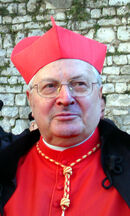
Cardinal Jean Chirac is said to be the father of Rildanorian unification.
Rildanor's pre-state history spans centuries of quarrelling small kingdoms and principalities with no real desire for unified rule. The Kingdom of Tirali, by far the strongest between 1799 and 2008, failed to unite Rildanorians, primarily due to interference from other countries in what is now Mordusia, Alduria, and Kanjor. In 2010, Cardinal Jean Chirac, the first minister to Tirali's King Kamadev, put forth the idea of unification of the Southern Seleyan states under the rule of a common monarch, but negotiations bore little fruit. The power centres of Austrian Mordusia strongly opposed the Tiralian plan, citing little similarities between the scattered peoples of South Seleya.
In 2048, the eastern Aldurian states of Bendiri and Zanyal launched an invasion of the western Duchy of Nirald, supposedly on the basis of historical right that dates back to the 1987 marriage of two aristocratic families that links Nirald with the two invaders. Tirali and the Duchy of Morbanack quickly mobilized their armies in defence of their Niraldanian brothers, quickly repelling Aldurian republican forces in a few months. It soon became apparent, then, that the Rildanorian states had to unite to repel future aggressive action by their neighbours. King Kamadev Jozefus of Tirali convened the fourth and final phase of the unification process and soon united Nirald, Morbanack, and Tirali under the Tiralian monarchy in December 2048. The island Kingdom of Meriath and the Kingdom of Zirdor adamantly refused to join, but would collapse after the bloody War of Rildanor. Kamadev Jozefus of the Leone Family was crowned King of Rildanor in Tirali City, then to be made capital.
Theocratic Monarchy
The birth of Rildanor failed to predict the strong interest of the Theognosian Church in national politics and in the everyday lives of the newly unified Rildanorian people. Christian parties held almost half of the early 36-member Sénat, with its first act of business being the issue concerning prayers in school. Throughout the remainder of the century, the Church would establish strong political and social control over Rildanor in what would be known as the Theocratic Monarchy. This period in the country's history would shape the country's evolution and can also explain the religion's continued existence in modern day Rildanor.
Rildanorian Civil War
The theocratic monarchy, however, soon collapsed amid controversy as both the Church and several aristocrats were engulfed in a scandal regarding the embezzlement of state funds. In 2267, a pro-republican government would unseat Edmund and put in its place the Republic of Rildanor.
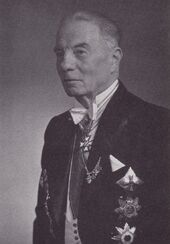
Kamadev Jozefus, the first King of Rildanor.
Many Communist youths were at first ecstatic about the end of the Church and the monarchy, but the republican government failed to address and meet the social issues plaguing Rildanor at the time. A Marxist revolution called MAREM overthrew President Mike Knox in 2270 and declared a Communist Republic shortly after. In 2274, a royalist uprising erupted in Meriath, led by the aging Edmund I and his son Hénri, which soon overran government forces on the island. When news of the revolt reached the mainland, many noblemen and their supporters quickly sailed for Meriath, hoping to rally behind Edmund and restore the monarchy. A planned invasion of Rildanor from Meriath soon took effect and royalist forces focused their attention on the capital Tirali, but the ensuing conflict drew in nearby countries, including Kanjor, Saridan, Aldegar, Kafuristan, Gishoto, Dorvik.
Princesse Arun, Edmund's granddaughter, would be crowned Queen of Rildanor after the Rildanor Peace Treaty was signed in 2285 in the new capital of Labonne, 200 km east of Tirali. The site for the new capital was chosen because of Labonne's defendable location and vast plots of untouched land, in sharp contrast to the more urban and overpopulated scene in Tirali. The Nareath monarchy would go undisturbed until 2401 when a surge in republican support once again overthrew the family.
Union de Seleya du Sud
In the 2450s, Rildanorian politicians introduced the idea of uniting all of southern Seleya under once country, an entity, they say, that makes sense given the near homogeneous Canrillaişe make-up of the region. Negotiations took nearly a decade, but generally well received in both Rildanor and Kanjor, while sparking little interest in Alduria. In May 2461, Rildanor and Kanjor ratified the treaty and officially formed the L'Union de Seleya du Sud (South Seleya). The system retained much of the two countries' systems, with alternating 5-year presidencies and cabinets. South Seleya, however, would eventually dismantle for two reasons; the two countries still largely performed as separate entities, with little being done in the international relations arena. Also, Rildanor had revived strong monarchist sentiments that required a withdrawal from a union with a staunchly republican character, thus ending the union in the 2490s. After 93 years of republican rule, the Nareaths were reinstated to the throne of Rildanor.
Government and Politics
Rildanor's politics has been branded as stable but unpredictable. The unpredictability lies in the several transitions between the monarchy and republic at various stages of the country's history. The stability of the country's politics refers to the normally bloodless and peaceful nature of these political transitions and the fact that few early elections are ever called. See also the Constitution of Rildanor.
Monarchy

King Léopold on the day of his coronation in 2611.
High King Philip II has reigned in Rildanor since 3495. He is Rildanor's third monarch from the House of Demitreus, which has been the Royal Family of Rildanor since his grandfather, Philip I, was appointed to the High Kingship in 3462.
While resistance to the monarchy in the past was common in the rhetoric of left-wing parties, it has largely faded to a non-issue. Today the Sovereign has an essentially ceremonial role restricted in exercise of power by convention and public opinion. However, the monarch does continue to exercise three essential rights: the right to be consulted, the right to advise and the right to warn. As a consequence of these ideals, the Prime Minister and Cabinet attends the regular meeting of the Council of State.
However, the real powers of position of the monarch in the constitution should not be downplayed. The Monarch does indeed retain some power, but it has to be used with discretion. He fulfils the necessary constitutional role as head of state, and acts as a final check on executive power. If a time came to pass, for instance, when a law threatened the freedom or security of his subjects, the King could decline Royal Assent, free as he is from the eddies of party politics and prosecution.
Political Parties
| Party | Leader | Description | |
|---|---|---|---|
Parti progressiste-conservateur |
Jean Tóraidhe | A progressive conservative party. | |
| Aristocrates Rildanoriens | Édouard-Philippe Olivier, Duc de Gelle | An Orthodox Catholic, pro-monarchy, right-wing conservative and aristocratic party that is Rildanor's oldest and longest running party. | |
| Parti Nationaliste | Linus Grande | A center right wing conservative party | |
Assemblee Nationale (Parlement Rildanorien)
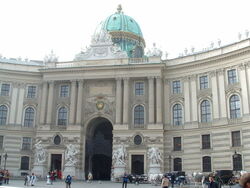
The Parlement Rildanorien in Labonne.
The Assemblee Nationale (formerly the Senat or Parlement Rildanorien) is the nation's elected legislature. It consists of 75 (formerly 750 in Parlement Rildanorien and 363 in Senat) members from all five cantons or kingdoms and its overseas territories. Elections are held every three years and all registered voters are required to vote.
Executive
Executive authority is exercised on behalf of the High King by the Premier Ministre (Prime Minister) and other cabinet ministers who head departments. The cabinet, including the Prime Minister and other ministers, collectively make up the government. These ministers are responsible to the Sénat, which is traditionally considered to be supreme (that is, able to legislate on any matter and not bound by decisions of its predecessors). The cabinet is normally made up of an alliance between various parties, often forming centre-left or centre-right coalitions.
Military
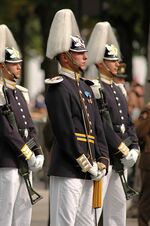
Changing the Guard, at the Château de Fontainebleau-Versailles, Labonne

The Rildanorian Royal Navy conducts naval exercises off the coast of Meriath.
The Army, Navy and Air Force are collectively known as the Rildanorian Armed Forces (or Her Majesty's Armed Forces) and officially the Armed Forces of the Crown. The commander-in-chief is the monarch, HM Queen Joséphine and they are managed by the Ministry of Defence. The armed forces are controlled by the Defence Council, chaired by the Chief of the Defence Staff.
Rildanor fields one of the most technologically advanced and best trained armed forces in the world. According to various sources, including the Ministry of Defence, Rildanor allocates about 20% of its budget to the military. It is one of the largest spender on military science, engineering and technology.
In 2561, the military had 1.38 million personnel on active duty, along with several hundred thousand each in the Reserves and the National Guard for a total of 2.3 million troops. The Ministry of Defence also employs approximately 700,000 civilians, disregarding contractors. Military service is voluntary, though conscription may occur in wartime through a resolution by the Sénat. The rapid deployment of Rildanorian forces is facilitated by the Air Force's large fleet of transportation aircraft and aerial refuelling tankers, the Navy's fleet of eleven active aircraft carriers, and Royal Marine Units at sea in the Navy's oceanic fleets.
The military also includes the Royal Guard battalion, which has two main roles; it serves as the monarch's lifeguards, guarding the royal residences and properties in the country, and is also the main infantry unit responsible for the defence of the capital Labonne. The Royal Guards number at around 25,000 soldiers, including 2,000 men who mainly appear in parades, ceremonies, and other royal functions. The armed forces is in theory under the direct command of the King or Queen of Rildanor. This is rarely the real case, however, as the monarch has a symbolic role rather than a political role.
Foreign Relations
Rildanor is a member of the Accord des Nations Amicales and serves as one of its founding members with veto rights. As a result of this, the country has an influential role in leading dedicated Accord members and Union Canrillaişe parties to war or political pressure. Rildanor also has several fellowship treaties with Indrala, Saridan, Lourenne, and Alduria. The treaties are mainly concerned with the maintenance of peaceful relations and the removal of protective trade policies, including tariffs, discriminatory taxes, subsidies or quotas. The free exchange of cultural and intellectual events/ideas/practises are also main points, which include shared commonalities such as the Canrillaişe character and the long history between the various nations. Rildanor generally approaches its relations with other countries on a cautious, case by case basis, which consequently grants it greater manoeuvrability in the global political arena.
Administrative Divisions
Administrative Divisions of Rildanor and its Overseas Territories
|- !Name !Status !Population[1] !Area !Capital !Other Cities !Senate Seats[2] !Unemployment |- |Meriath |Canton||31,025,428||283,200 km²||Leexis||Saint-Antoine, Leria, Bezons||14||3.96% |- |Morbanack |Canton||42,218,178||339,600 km²||Thallori||Fontaine, Moisdonne, Arloux||19||5.98% |- |Nirald |Canton||39,515,457||407,400 km²||Gelle||Segre-Sabie, Croix, Tenay-le-Cents||17||9.37% |- |Tirali |Canton||45,205,578||433,200 km²||Tirali City[3]||Labonne, Malini, Alkenne||20||3.91% |- |Zirdor |Canton||50,844,660||215,700 km²||Port Retagne||Ville-sur-Cenx, Saclay, Cenlati||79||3.51% |- |Noumonde[4] |Colony||10,083,905[5]||243,600 km²[6]||Rennes||Nordeaux, Lille, Charlesbourg||5||14.3% |- !colspan=2|Total[7]!!224,376,255!!1,922,700 km²!! !! !!100!!6.83% |}
- ↑ 2575 estimates. Last census was held in 2511, which differ drastically.
- ↑ Seat allocation appears differently on the nation page because the Comité Central d'Élection does not hold offices outside of Rildanor Proper. Senateurs from overseas territories, therefore, must register on the mainland. The figures shown here are accurate.
- ↑ While Tirali City is the capital of Tirali, Labonne remains the the national capital.
- ↑ The colony of Noumonde, located on the western coast of Squibble, was claimed by the Rildanorian government in the early 2560s and was officially formed in 2569 by an act of the Sénat. The formation of the colony came after negotiations with Alduria and Beiteynu, two countries with large claims to the entire continent.
- ↑ Some native groups may be unaccounted for.
- ↑ Noumonde's land area is based on a rough estimation by the colonial administration. A detailed study of the area has yet to be performed.
- ↑ All figures shown here include Noumonde, thereby creating different results from Rildanor Proper, which appear elsewhere.
Demographics
Rildanor's population has surpassed 100,114,433 in 2575 and the country proudly has the largest Canrillaişe population anywhere on Terra. In 3210, the government conducted a study to determine demographics of the country. The results are published in the Recensement national - Rildanor Census, 3210 bill.
Ethnicity
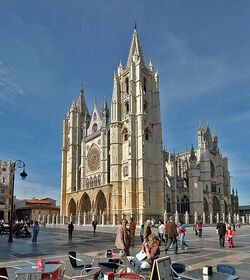
Cathedrals are a common sight in many major Rildanorian cities, such as the Cathédrale Notre-Dame de Arloux in Arloux, Morbanack.
Approximately 94% of all Rildanorian residents identify themselves as Canrillaişe-Rildanoriennes or simply Rildanorian. With over 100 million Canrillaişe, a vast array of cultural traditions have thus been handed down for centuries and continues to be practised and honoured today. About 3% of the population come from Rildanor's immediate neighbours and historic partners: Mordusia, Alduria, Kanjor, and Lourenne. Although most of them are technically Canrillaişe, they continue and prefer to be identified by their country of origin. The remaining 3% are foreign diplomats/businessmen, illegal aliens and people of mixed descent.
In 3210, the government attempted to limit the non-Rildanorian, and specifically the non-Canrillaişe, population by removing ethnic minorities and immigrants in the Deportation of Migrants and Minorities Act
Religion
The largest religious group in Rildanor is Theognosianism, comprising of more than 85% of the country's population. While a growing number of Rildanorians do not actively practice the national faith, most still continue to identify with the Church for historical and cultural reasons. Other Christian groups number around 5%. At 10%, atheists (or those who do not adhere to any religion) have grown throughout the country and is a reflection of Rildanor's changing attitudes toward organized religions.
Language
Rildanor's official language is Canrillaişe and was formally recognized as such in the Official Canrillaişe Act, 2368. The bill is a further recognition of the country's true Canrillaişe identity and its dominance among the world Canrillaişe population.
Canrillaişe is today mandatory in schools, workplaces and government, and programs are funded by the Rildanor Government to promote it outside of the country, particularly in South Seleya where there are countries with sizable Canrillaişe populations. Other languages, however, are still widely tolerated and protected under law.
Economy
| Economy of Rildanor | |
|---|---|
| National economic indicators | |
| Unemployment | 5.3% |
| GDP growth | 4.9% |
| CPI inflation | 3.0% |
| National debt | none |
| Poverty | 6.3% |
Rildanor is one of the Seleya's wealthiest nations, with a high per-capita income and robust annual growth rates, fuelled by abundant natural resources, a well-developed infrastructure, and high productivity.

The automobile industry is especially profitable in both domestic and international markets.
The private sector constitutes the bulk of the economy, with government activity accounting for 12.4% of GDP. The economy is postindustrial, with the service sector contributing 67.8% of GDP. The leading business field by gross business receipts is wholesale and retail trade; by net income it is finance and insurance. Rildanor remains an industrial power, with chemical products the leading manufacturing field. It is one of the largest producers of oil in the world, and also one of its largest consumers.
Rildanor is one of the world's most important suppliers of agricultural products, with Morbanack and Nirald being one of the most important suppliers of wheat, canola and other grains. Rildanor is the world's largest producer of zinc and uranium and a world leader in many other natural resources such as gold, nickel, aluminum, and lead; many, if not most, towns in the canton of Meriath, where agriculture is difficult, exist because of a nearby mine or source of timber. Rildanor also has a sizable manufacturing sector centred in Tirali and Zirdor, with automobiles and aeronautics representing particularly important industries.
The service sector of Rildanor is dominated by financial services, especially in banking and insurance. The Rildanorian manufacturing sector, however, has greatly diminished, relative to the economy as a whole, since the 24th century. It is still a significant part of the economy, but only accounted for one-sixth of national output in recent years.
Culture
The culture of Rildanor and of the Rildanorian people has been shaped by its geography, by profound historical events, and by foreign and internal forces and groups. Rildanor, and in particular Labonne and Tirali, has played an important role as a centre of high culture and of decorative arts since the twenty-first century, first in Seleya, and from the twenty-second century on, world wide. The importance of Rildanorian Canrillaişe culture has waned and waxed over the centuries, depending on its economic, political and military importance. Today it is marked both by great regional and socioeconomic differences and by strong unifying tendencies.
Cuisine

Rildanorian cuisine is as much about presentation as it is about taste.
Traditional Rildanorian culture places a high priority on the enjoyment of food. Cuisine was codified in the 23rd century by Antoinne Auguste, effectively placing greater importance on a more unified cuisine that overshadowed regional varieties. Rildanorians typically eat only a simple breakfast ("petit déjeuner") (of, say, coffee or tea, served traditionally in a large handleless "bol" and bread, breakfast pastries (croissants), or yogurt. Lunch ("déjeuner") and dinner ("dîner") are the main meals of the day. Formal four course meals consist of a starter course ("entrée"), a main course ("plat principal") followed by a salad course, and finally a cheese and/or a desert course. While Rildanorian cuisine is often associated with rich deserts, in most homes desert consists of only a fruit or yogurt.
In Rildanor, cutlery is used in the continental manner (with the fork in the left hand, prongs facing down and the knife in the right hand). The legal drinking age is officially 18 for strong liquors (21% vol. alcohol), and 16 for most alcohol drinks (beer, wine, etc.). Wine, in particular, usually accompanies both lunch and dinner meals, while other liqueurs are occasionally enjoyed.
Sports

The Vendée Globe is a round-the-world single-handed yacht race, sailed non-stop and without assistance.
The Rildanorian national sport is football (soccer), colloquially called 'le foot'. The most-watched sports in the country are football, rugby, basketball, cycling, sailing and tennis. Rildanor is notable for holding a series of national and international football championships, as well as the annual cycling race Tour de Rildanor. Sports are encouraged in school, and local sports clubs receive financial support from private companies, if not from local governments and community groups. Professional sailing is also popular and is centred on singlehanded/shorthanded ocean racing, with the pinnacle of this branch of the sport being the Vendée Globe single-handed competition, which is a race around the world that takes place every 4 years off the coast of Meriath.
Media
Rildanorians are among the greatest consumers of newspapers in the world, and nearly every town is served by a local paper. The country's main quality morning papers are The Rildanor Daily, focused mainly on domestic events, and The Rildanor Journal, an international paper that is the main news source for foreign governments and Rildanorian nationals living abroad.
Gallery
| Rildanor articles | ||
| History | Union Canrillaişe | |
| Geography | Cities | |
| Politics | Political parties - Supreme Court - Elections - Viceroy - Prime Minister - Ministers - National Asssembly - Opposition | |
| Demographics | Ethnic groups: Canrillaise Religion: Aurorian Patriarchal Church | |
| Culture | Sport - Monarchy - Armed Forces - National anthem - Nobility | |
| Economy | Banking | |
| Nations of Seleya | ||
| Sovereign states | Aldegar - Alduria - Baltusia - Gaduridos - Indrala - Kalistan - Kanjor - Likatonia - Lodamun - Mordusia - Rildanor - Saridan - Tukarali - Valruzia | |













